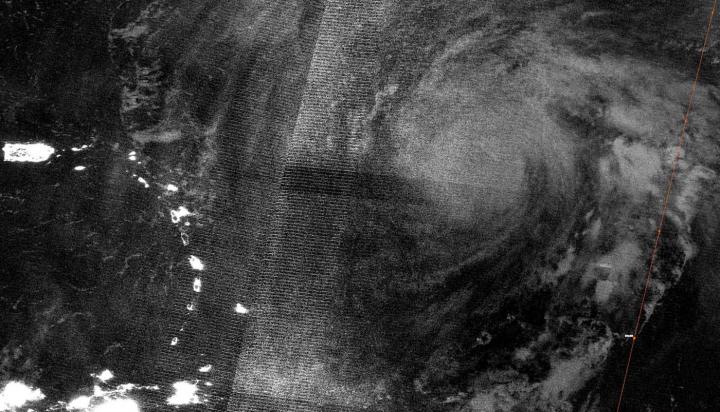
Credit: Credit: NASA Worldview, Earth Observing System Data and Information System (EOSDIS)
An early morning infrared image of Hurricane Teddy taken from NASA-NOAA’s Suomi NPP satellite shows the proximity of the strengthening hurricane to the Lesser Antilles island chain and Puerto Rico. Teddy is a major hurricane on the Saffir-Simpson Hurricane Wind Scale.
NASA-NOAA’s Suomi NPP satellite passed the North Atlantic Ocean overnight on Sept. 17 at 12:40 a.m. EDT (0440 UTC). The Visible Infrared Imaging Radiometer Suite (VIIRS) instrument aboard Suomi NPP provided a nighttime image of Hurricane Teddy. Puerto Rico and the Lesser Antilles can be seen lit up by night lights to the west in the image. The Lesser Antilles a group of islands that frame the eastern side of the Caribbean Sea.
The image was created using the NASA Worldview application at NASA’s Goddard Space Flight Center in Greenbelt, Md.
By 11 a.m. EDT infrared imagery revealed Teddy’s satellite appearance had steadily developed. There is now a ragged warming eye surrounded by a ring of convection with cloud tops colder than minus 76 degrees Fahrenheit/minus 60 degrees Celsius.
Teddy’s Status on Sept. 17
At 11 a.m. EDT (1500 UTC), National Hurricane Center (NHC) said the center of Hurricane Teddy was located near latitude 19.3 degrees north and longitude 53.0 degrees west. Teddy was about 610 miles (980 km) east-northeast of the Lesser Antilles.
Teddy is moving toward the northwest near 12 mph (19 kph) and this motion is expected to continue for the next few days. Maximum sustained winds were near 120 mph (195 kph) with higher gusts. Teddy is a category 3 hurricane on the Saffir-Simpson Hurricane Wind Scale. The estimated minimum central pressure is 957 millibars.
Teddy’s Forecast
Some additional strengthening is possible through tonight as Teddy moves northwest. A slow weakening trend is expected to begin over the weekend.
###
About NASA’s EOSDIS Worldview
NASA’s Earth Observing System Data and Information System (EOSDIS) Worldview application provides the capability to interactively browse over 700 global, full-resolution satellite imagery layers and then download the underlying data. Many of the available imagery layers are updated within three hours of observation, essentially showing the entire Earth as it looks “right now.”
NASA Researches Earth from Space
For more than five decades, NASA has used the vantage point of space to understand and explore our home planet, improve lives and safeguard our future. NASA brings together technology, science, and unique global Earth observations to provide societal benefits and strengthen our nation. Advancing knowledge of our home planet contributes directly to America’s leadership in space and scientific exploration.
For updated forecasts, visit: http://www.
By Rob Gutro
NASA’s Goddard Space Flight Center
Media Contact
Rob Gutro
[email protected]
Original Source
https:/




